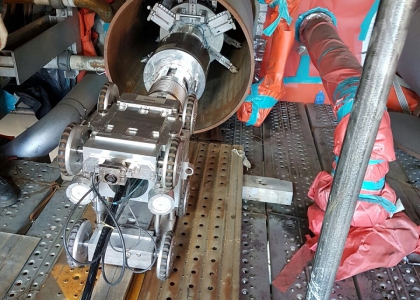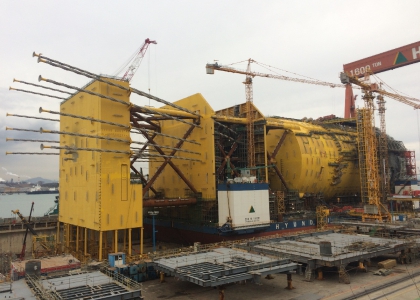Welding seams are corrected by grinding robots in piece work application. The Aasta Hansten oil platform of the Statoil company is one of the most extensive and highly complex industrial projects in Europe. The destination of the oil platform lies 300 kilometres from the west coast of Norway.
There, working depths of up to 1300 metres below sea level should be reached. Manufactured by Hyundai Heavy Industries in South Korea, in future the platform should be capable of extracting 23 million cubic metres of oil and gas per day. Thus one of the largest offshore projects of its kind should be launched in 2018.
Irregular pipe welds threatened the completion of the final construct
In order to bring crude oil and natural gas to a platform from a depth of 1300 metres, steel pipelines are used. In turn, during laying, these pipelines in steel are drawn through the platform by so-called "pull tubes" and are anchored there. In doing so the pipelines are pulled through more than 200 metre long "umbilical tubes". The special thing is: The internal diameter of these special umbilical tubes is only slightly bigger than the external diameter of the pipelines to be pulled through.
On the one hand to ensure correct anchoring and on the other to avoid damage to the pull tubes during the laying through the umbilical tubes, certain standards are prescribed for the diameter of the pipeline. On the final inspection and assessment of the total structure, it was determined, however, that the various weld seams of the umbilical tubes had a too high raised weld seam and therefore the pull tubes could not be pulled through the umbilical tubes.
Therefore Hyundai Heavy Industries was faced with the problem of carrying out the laying of the pipelines as envisaged. The acceptance of the complete Aasta Hansten oil platform, the largest ever built of this kind, threatened to come to a halt shortly before the planned shipment. For this major project, an unthinkable predicament.
INSPECTOR SYSTEMS was able to come to the rescue with its grinding robots
Post-grinding and restoration were the only practicable solutions. The grinding robots and grinding manipulators of INSPECTOR SYSTEMS have been specially developed for the restoration of imperfections and the processing of the weld roots within a pipeline system. Through the use of two different grinding robots (Type GS 6000 / DN 420 up to 800mm and Type GS 4000M / DN 250 up to 400mm) pipes (umbilical tubes) with different diameters could be ground from the inside. Due to their flexibility, the robots are able to travel through the pipeline under remote control and to accurately correct each desired seam down to a tenth of a millimetre.
A Double Challenge
The adaptation based on reports from previously carried out laser profile measurements was uncharted territory for Inspector Systems. The time pressure and the impending project delay of the Statoil Aasta Hansen oil platform did not make the work any easier.
Six employs worked 24 hours on site. Within three weeks over Christmas and New Year, 2016, approx. 300 weld seams were corrected and defects remedied. Subsequent inspections showed optimum results. The grinding of the seams had the result that the required nominal pipeline diameters in the areas of the weld seams had been complied with. In addition, this lead to a considerable improvement of the surface quality. An additional quality improvement of the welded joint especially with mechanical loads.
INSPECTOR SYSTEMS quickly and efficiently made an excellent service available. With this action, it was ensured that the subsequent project phases for Hyundai Heavy Industries and Statoil could be implemented in this mega project as planned without delay and without significant additional costs.



